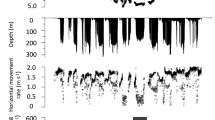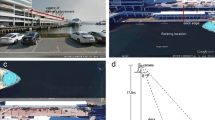Abstract
Information about foraging speeds is particularly valuable when the impact of a predator species upon a community of prey has to be defined, as in the case of great cormorants. We measured the swim speed of 12 (six males and six females) free-ranging great cormorants Phalacrocorax carbo, foraging off the Greenland coast during the summer of 2003, using miniaturized data-loggers. Although mean body mass of males was 27% greater than that of females, and mean swim speed of males were 29–57% higher than that of females during foraging phases (but not descent phases) of dives, these differences in speeds were not significant due to high variances. Birds descended to the mean maximum depth of 4.7 m at an average speed of 1.6±0.5 m s−1, a speed similar to that measured in captive cormorants in previous studies. Although bursts of up to 4 m s−1 were recorded, speed usually decreased during the deepest (foraging) phase of dives, being on average 0.8±0.6 m s−1. Speeds measured here should be taken with caution, because the large propeller loggers used to measure speed directly decreased descent speeds by up to 0.5 m s−1 when compared to smaller depth-only loggers. Cormorants in Greenland seem to combine two searching strategies, one requiring low speed to scan the water column or benthos, and one requiring high speed to pursue prey. These two strategies depend on the two main habitats of their prey: pelagic or demersal.




Similar content being viewed by others
References
Bainbridge R (1958) The speed of swimming as related to size and to the frequency and amplitude of the tail beat. J Exp Biol 35:109–133
Bannasch R, Wilson RP, Culik BM (1994) Hydrodynamic aspects of design and attachment of a back-mounted device in penguins. J Exp Biol 194:83–96
Beddow TA, van Leeuwen JL, Johnston IA (1995) Swimming kinematics of fast starts are altered by temperature acclimation in the marine fish Myoxocephalus scorpius. J Exp Biol 198:203–208
Bell WJ (1991) Searching behaviour: the behavioural ecology of finding resources. Chapman & Hall, London
Blackwell SB, Haverl CA, Le Boeuf BJ, Costa DP (1999) A method for calibrating swim-speed recorders. Mar Mamm Sci 15:894–905
Carss DN, Bregnballe T, Keller TM, van Eerden M (2003) Reducing the conflict between Cormorants Phalacrocorax carbo and fisheries on a pan-European scale: REDCAFE opens for business. Vogelwelt 124:299–307
Cramp S, Simmons KEL (eds) (1977) Handbook of the Birds of Europe, the Middle East and North Africa. The Birds of the Western Palearctic, vol 1. Oxford University Press, Oxford
Croll DA, Gaston AJ, Burger AE, Konof D (1992) Foraging behavior and physiological adaptation for diving in Thick-billed murres. Ecology 73:344–356
Froese R, Pauly D (2003) FishBase. World Wide Web electronic publication. (http//www.fishbase.org), version 14 April 2004
Grémillet D, Argentin G, Schulte B, Culik BM (1998) Flexible foraging techniques in breeding Cormorants Phalacrocorax carbo and Shags Phalacrocorax aristotelis: benthic or pelagic feeding? Ibis 140:113–119
Grémillet D (1997) Catch per unit effort, foraging efficiency and parental investment in breeding Great Cormorants (Phalacrocorax carbo carbo). ICES J Mar Sci 54:635–644
Grémillet D, Wilson RP, Gary Y, Storch S (1999) Three-dimensional space utilization by a marine predator. Mar Ecol Prog Ser 183:263–273
Grémillet D, Kuntz G, Delbart F, Mellet M, Kato A, Robin J-P, Chaillon P-E, Gendner J-P, Lorentsen S-H, Le Maho Y (2004) Linking the foraging performance of a marine predator with local prey abundance. Funct Ecol 18:793–801
Hustler K (1992) Buoyancy and its constraints on the underwater foraging behaviour of Reed Cormorants Phalacrocorax africanus and Darters Anhinga melanogaster. Ibis 134:229–236
Jordan AD, Herbert NA, Steffensen JF (2005) Escape performance in three teleosts from West Greenland. Polar Biol 28:164–167
Kato A, Watanuki Y, Shaughnessy P, Le Maho Y, Naito Y (1999) Intersexual differences in the diving behaviour of foraging subantarctic cormorant (Phalacrocorax albiventer) and Japanese cormorant (P. filamentosus). C-R Acad Sci Paris 322:557–562
Koffijberg K, van Eerden MR (1995) Sexual dimorphism in the cormorant Phalacrocorax carbo sinensis: possible implications for difference in structural size. Ardea 83:37–46
Muus BJ, Dahlström P (1974) Collins guide to the sea fishes of Britain and North-Western Europe. Collins, London
O’Steen S, Bennett AF (2003) Thermal acclimation effects differ between voluntary, maximum, and critical swimming velocities in two cyprinid fishes. Physiol Biochem Zool 76:484–496
Patterson HD, Thompson R (1971) Recovery of inter-block information when block sizes are unequal. Biometrika 58:545–555
Pitcher TJ, Parrish JK (1993) Functions of shoaling behaviour in teleosts. In: Pitcher TJ (ed) Behaviour of Teleost Fishes, 2nd edn. Chapman & Hall, London, pp 369–439
Press WH, Flannery BP, Teukolsky SA, Vetterling WT (1988) Numerical Recipes in C. Cambridge University Press, Cambridge
Ropert-Coudert Y, Bost C-A, Bevan RM, Handrich Y, Le Maho Y, Woakes A, Butler PJ (2000) Impact of externally attached logger on the diving behaviour of the King penguin (Aptenodytes patagonicus). Physiol Biochem Zool 74:438–444
Ropert-Coudert Y, Kato A, Baudat J, Sato K, Bost C-A, Le Maho Y, Naito Y (2002) Swim speed of free-ranging Adélie penguins, Pygoscelis adeliae, and relation to the maximum depth of dives. J Avian Biol 33:95–99
Ropert-Coudert Y, Grémillet D, Ryan PG, Kato A, Naito Y, Le Maho Y (2004) Between air and water: the plunge dive of the Cape Gannet Morus capensis. Ibis 146:281–290
Ropert-Coudert Y, Wilson RP (2005) Trends and perspectives in animal-attached remote-sensing. Front Ecol Environ 3(8):437–444
Russell IC, Dare PJ, Eaton DR, Armstrong JA (1996) Assessment of the problem of fish-eating birds in inland fisheries in England and Wales. Report to the Ministry of Agriculture, Fisheries and Food (MAFF Project VC0104)
Sambilay VC Jr (1990) Interrelationships between swimming speed, caudal fin aspect ratio and body length of fishes. Fishbyte 8:16–20
Sato K, Naito Y, Kato A, Niizuma Y, Watanuki Y, Charrassin J-B, Bost C-A, Handrich Y, Le Maho Y (2002) Buoyancy and maximal dive depth in penguins: do they control inhaling air volume? J Exp Biol 205:1189–1197
Schmid D, Grémillet D, Culik BM (1995) Energetics of underwater swimming in the Great Cormorant (Phalacrocorax carbo sinensis). Mar Biol 123:875–881
Voslamber B, van Eerden MR (1991) The habit of mass flocking fishing by cormorants Phalacrocorax carbo sinensis at the IJsselmeer, The Netherlands. In: van Eerden MR, Zijlstra M (eds) Proceedings Workshop 1989 on Cormorants Phalacrocorax carbo. Rijkswaterstaat Directorate Flevoland, Lelystad, pp 182–191
Wilson RP (1995) Foraging ecology. In: Perrins C, Bock W, Kikkawa J (eds) Bird families of the world: the penguins spheniscidae. Oxford University Press, Oxford, pp 81–106
Wilson RP, Culik BM, Peters G, Bannasch R (1996) Diving behaviour of Gentoo penguins, Pygoscelis papua; factors keeping dive profiles in shape. Mar Biol 126:153–162
Wilson RP, Ropert-Coudert Y, Kato A (2002) Rush and grab strategies in foraging marine endotherms: the case for haste in penguins. Anim Behav 63:85–95
Wilson RP, Grant WS, Duffy DC (1986) Recording devices on free-ranging marine animals: does measurement affect foraging performance? Ecology 67:1091–1093
Wilson RP, Wilson M-PT (1988) Foraging behaviour of four sympatric cormorants. J Anim Ecol 57:943–953
Acknowledgements
This study was funded by the Institut Polaire Français Paul-Emile Victor through the Grant N°388 to DG and by the Centre National de la Recherche Scientifique. The Arctic Station in Godhavn provided logistics support throughout repeated field seasons on Disko. The experiments comply with the current laws of Greenland and the experimental procedure was validated by the ethics committee of the French Polar Institute, The Greenland Homerule Government, the Danish veterinary services, the Danish Polar Center, and the science board of Arctic station. We thank C. Gilbert, E. Pettex, C. Devred and G. Bastholm for their help in data collection; J. Metcalfe, I. Russell, R. Williams and A. Jordan for sharing information about fish swim speed; Prof. Y. Naito for kindly providing us with the swim speed data loggers. Finally, three anonymous referees considerably helped us improving the manuscript.
Author information
Authors and Affiliations
Corresponding author
Additional information
Communicated by S. Nishida, Tokyo
Rights and permissions
About this article
Cite this article
Ropert-Coudert, Y., Grémillet, D. & Kato, A. Swim speeds of free-ranging great cormorants. Mar Biol 149, 415–422 (2006). https://doi.org/10.1007/s00227-005-0242-8
Received:
Accepted:
Published:
Issue Date:
DOI: https://doi.org/10.1007/s00227-005-0242-8




